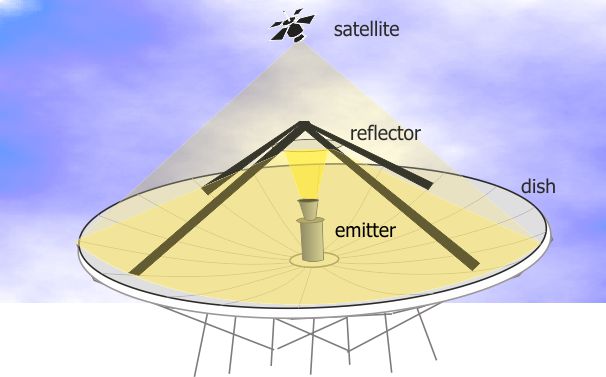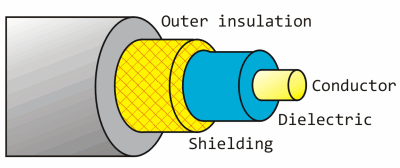Freesat reception - all about dishes
 Brian Butterworth published on UK Free TV
Brian Butterworth published on UK Free TV Satellite reception has both advantages and disadvantages compare with terrestrial (aerial) reception.
By using much higher frequencies (gigahertz, compared to terrestrial televisions megahertz) more transmission channels called transponders (the satellite equivalent of multiplexes) can be provided. For example, there are only six Freeview multiplexes, but Sky or Freesat users can access two hundred satellite transponders.
Aside from exceptional weather conditions (very heavy rain for example) digital satellite provides stable pictures and audio. Where Freeview transmitters are no more than 732 metres above sea level, the geostationary satellites used for television are 35,800,000 metres above the equator so reception is possible even where buildings, trees and hills make terrestrial reception impossible.

The downside of the transmitters being 22,300 miles up in the air is that the signals are very, very weak - so standard TV aerial is of little use. When the signals are sent to the satellites, huge dish transmitters are used to uplink the signal to the satellite. These are tens of metres from side to side, and feature an emitter that generates the signal, which is first bounced of a mirror (called a reflector) and then off the surface of the parabolic dish.

There are many satellites in the sky over the equator. Often these are in clusters over a particular position, for example there are four used for UK television are at 28.2 degrees east. There is another cluster over the 19.2 degrees east positions that are used for German television.
To receive these very weak signals from the satellite, it is necessary to use a dish for reception too. By using a reflective dish, this concentrates the signals onto a small device called a LNB. This is held in front of the dish by a metal arm.

The size of dish for reception is typically much smaller; often 60cm to 100cm in diameter, but the exact size depends upon the transmitting satellite transponder. To keep the transmission power levels down to levels that can be powered by the satellite's solar panels, each beam is focused on a particular area of the Earth's surface. If you are trying to receive the signal at the centre of this zone, a small dish is required. At the outer edges, you may need a 5 metre dish. Maps of these zones are provided by the satellite companies, and are called satellite footprints.
When the dish is installed it must be aligned carefully as the signal is very weak. The installer needs to know the inclination and the azimuth from the ground location to the satellite. If you install yourself you will find that there are markings on the dish that are used to point the dish in the correct position. It is important that the view of the satellite will not be blocked, so must take into account leaves growing on trees and potential building works.
For many people the LNB will have a single cable connected to it, however if you have Sky+ or a multi-room installation the LNB package will actually contain four receivers a quad-LNB. Unlike terrestrial television where you can split the aerial cable to feed more than one Freeview box or television set, with satelite reception you cannot. So, a Sky+ box with two receivers (so you can watch one thing and record another) has two cables connecting the box to the dish.
The cable that connects the dish to the receiver must be satellite grade cable. Whilst this looks superficially like the cable used to connect and aerial to a television, a higher grade cable is required for satellite reception.
Here is an image of a co-axial cable. This sort of cable is used to connect any type of receiving aerial to the reception equipment.

RG6, PF100 and PH100 are all types of coax cable that are suitable for the very weak signals that are received by a satellite dish. (The power is the same as you would receive from a one-bar electric heater on the moon).
The conductor in the centre passes the signals received from the dish to the set-top box. This is made from steel in RG6 cable, and from copper in the RF100 and PH100 types. This makes RG6 less suitable in the UK where rain can damage the cable.
The shielding is responsible for keeping unwanted external interference from damaging the signal. In the cheaper cable this will be a foil wrap, in better specified cables this is a braid (or mesh) of copper wires. The sheild in the RF100 covers 58% of the cable.
The non-conducting layer between the shield and the conductor is called the dielectric. This can be either a solid (RG6), foam (RF100) or air-spaced (PH100) dielectric. This makes the cables progressively more flexible (ie bendy without damage).
4:55 PM
Jim: Yes, you really need a receiver that supports DiSEqC to switch between the different feeds. You can get manual switches but it's likely that different satellite clusters will use the same frequencies for different channels.
There are Freesat receivers that support DiSEqC - you would need to put it in non-Freesat mode to tune in the other satellites. There are also Free-To-Air receivers, not Freesat-branded, which will treat all satellite clusters equally, but won't show all the Freesat EPG data. Sky boxes do not support DiSEqC.
| link to this comment |
8:30 PM
Thanks Mike your comments were very helpful. Regards Jim.
| link to this comment |
8:24 AM
My elderly Mum lives in a retirement complex of flats. She paid the once-off fee for Sky Freesat and had a mini dish put up. My question is who owns the dish? We assumed that it was her property, but sky have started to connect others to the same dish and have told her that there is nothing she can do about it. Is this correct?
| link to this comment |
4:48 PM
Jill: Well the statement of Sky / Freesat is really a contradictory one insomuch that these are separate services received by two different types of satellite boxes, either a Freesat one or alternatively a Sky box.
The point is, that if your Mum paid for a mini dish to be set up for her exclusive use then it belongs to her, as its not connected to any possible Sky installation that the complex might have and as such they have no right to connect anything to it without your Mums approval, which she should not give as someone else is effectively cashing in on your Mums installation.
Its really the case of who installed the set up for her? and does it state "Sky" anywhere on her Satellite receiver box? as if it does then that "might" indicate that the complex possibly has some tie up with Sky as far as them providing equipment.
Did your Mum sign any contract with Sky?
| link to this comment |
Hi, firstly great work here. The feedback you give out looks really helpful. I was hoping you could shed some light on my problem.
I have bush hd freesat box. I get 0% signal on setup. I've replaced the box with another, replaced the lnb, checked the coax for breaks and used dishpointer to align my dish. I've also had an electrician check the cabling.
Am I getting 0% signal because the dish is not aligned exactly right? So far I'm just emulating other dishes in my proximitey in the hope I get even 1% signal. Do I need to be more accurate than this?
If not, why else would I be having issues with my sattelite dish? I bought a kit from ebay and have replaced multiple parts since in a bid to resolve the issue.
Thanks for your help in advanced.
Ty
| link to this comment |
3:51 PM
Ty Fairclough: Even the most experienced of dish installers would not be able to detect a dish being a fraction out of alignment as they are so highly critical and can lose a signal with even the merest of nudges.
If you wish to persevere with attempting to align the dish then you should purchase one of these simple devices that you will find advertised for this purpose in various places, particularly e-bay, these devices giving an audible indication of a signal as well as a visual one, either via a row of LED's and other types a meter.
The biggest mistake made by most people when using these devices is "not" doing things in slow motion, plus another commonly made mistake when sweeping across in the horizontal plane from left to right is accidentally stopping on the 19.2 position rather than 28.2, as there is barely a faction of a difference between each position.
The secret of success is to allocate at least about 20 minutes or so time for the job, and its also of considerable assistance that if its at all possible to view the TV whilst doing the job, then set the box on its signal strength / quality indicator screen and give the dish a final trim whilst viewing the results.
PS: Remember that the LNB is not positioned on the dish sitting perfectly straight, but is turned slightly clockwise to roughly just past the one o'clock position. (called Skew setting)
| link to this comment |
4:47 PM
Ty Fairclough: just to clarify, when it say
"Even the most experienced of dish installers would not be able to detect a dish being a fraction out of alignment" etc, I am of course meaning in the visual sense.
| link to this comment |
I lost all satellite reception last night due to snow.
If you lose your satellite reception it may be due to snow on the satellite dish and/or dish LNB.
If you can reach your dish safely then just dust off the snow.
Otherwise you should get a signal again when the snow melts.
If you can remove the snow from the dish, make sure you don't change the dish angle.
| link to this comment |
Mark's: mapM's Freeview map terrainM's terrain plot wavesM's frequency data M's Freeview Detailed Coverage
11:12 AM
hi i have sky hd and sd in my bedroom will i need to buy a freesat box for each room thanks
bob.
| link to this comment |